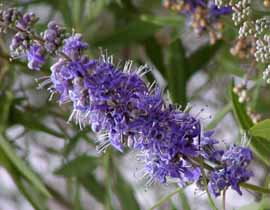|
Chasteberry
Introduction[Top] Chasteberry comes from the chaste tree. It is native to the Mediterranean and central Asia. The Latin name is vitex agnus castus. The other names are
What vitex is used for[Top] vitex is used to alleviate symptoms of an assortment of gynecological problems these include
Additionally it is also used to treat fibroid cysts and reducing acne in teenagers. It is used in some supplements for male bodybuilders as a secondary component because of its effects on testosterone levels. The dried ripe vitex is used to concoct solid
extracts or liquid extracts which are put inside capsules and tablets.
How Vitex is used[Top] vitex can be taken as a
To make a vitex tea put one tablespoon into a cup of boiling water and steeped ten to fifteen minutes.
Science Says[Top] Studies show that vitex can both increase and decrease prolactin levels in the body. Too much prolactin can result in breast tenderness and amenorrhea (no menstrual periods) which is associated with PMS. Too little prolactin can result in a reduction in milk production. A clinic study that featured one hundred nursing mothers showed that mothers who took chasteberry produced more milk than the mums who had taken a placebo. German studies also show that vitex may also help prevent a miscarriage. It is one of the ten herbs approved by the DOH. (Philippine department of health)
cautions and side affects[Top] Vitex is not linked with any major side effects. It can however cause
Return to natural healing home page
|
Loading



